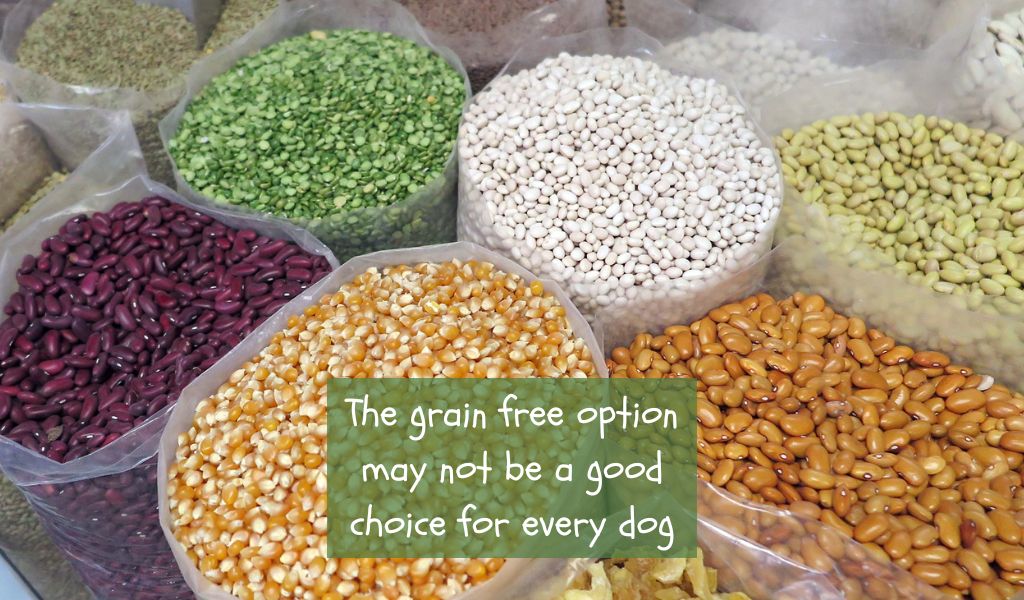As a dog owner, you always want to provide the best for your pet.
One of the major decisions you’ll face is selecting the right dog food and with the rising popularity of grain-free dog food, you might be wondering if it’s a healthier choice for your canine companion.
In this article, we’ll delve into the truth behind grain-free dog food, discussing its benefits and drawbacks, and help you make an informed decision for your dog’s diet.
Grain-free dog food can be a healthy choice for some dogs, especially those with grain allergies or sensitivities. However, it’s not suitable for all dogs and may have potential drawbacks, such as nutritional imbalance or a potential link to heart disease.
What is Grain-Free Dog Food?
Definition
Grain-free dog food is a type of dog food formulated without grains such as wheat, corn, rice, and oats. It aims to provide a diet that more closely resembles what dogs might eat in the wild.
Common Ingredients
Grain-free dog foods often use alternative carbohydrate sources, like sweet potatoes, peas, or lentils.
They typically contain higher amounts of protein from meat, fish, or poultry sources.

The Grain-Free Dog Food Trend
The grain-free dog food trend began as a response to concerns about potential allergies and sensitivities to grains.
Proponents of grain-free diets argue that dogs are not designed to digest grains, as their wild ancestors primarily consumed meat.
However, it’s important to note that domesticated dogs have evolved to digest carbohydrates more efficiently than their wild counterparts.
Potential Benefits of Grain-Free Dog Food
Allergies and Sensitivities
One of the main reasons pet owners choose grain-free dog food is to address allergies or sensitivities to grains.
Some dogs may experience skin irritations, digestive issues, or ear infections as a result of grain consumption.
For these dogs, a grain-free diet might provide relief from these symptoms.
Digestibility
Grain-free dog food can be easier to digest for some dogs, particularly those with sensitive stomachs.
High-quality proteins and alternative carbohydrates might be more digestible than grains for certain dogs.
Weight Management
Grain-free dog food often has a higher protein and lower carbohydrate content, which can help some dogs maintain a healthy weight.
However, it’s crucial to monitor your dog’s calorie intake, as grain-free foods can also be calorie-dense.
Potential Drawbacks of Grain-Free Dog Food
Nutritional Imbalance
Some grain-free dog foods may lack essential nutrients, leading to nutritional imbalances.
It’s essential to choose a grain-free diet that is nutritionally complete and balanced to avoid deficiencies or excesses.
Grain-Free and Heart Disease
Recent studies have raised concerns about a potential link between grain-free dog food and an increased risk of a heart condition called dilated cardiomyopathy (DCM).
Further research is needed to fully understand this connection, but it’s worth considering when choosing a dog food.
High Cost
Grain-free dog food tends to be more expensive than traditional dog food due to the use of higher-quality protein sources and alternative carbohydrate ingredients. Depending on your budget, this may be a significant drawback.
How to Choose the Right Dog Food
Know Your Dog’s Needs
Understanding your dog’s specific nutritional requirements, activity level, and health status is crucial when selecting the right dog food.
Factors such as age, breed, and any existing health conditions should be considered.
Consult a Veterinarian
Your veterinarian is an excellent resource for guidance on the best diet for your dog.
They can assess your dog’s overall health and make recommendations based on their expertise and knowledge of your dog’s unique needs.
Look for Quality Ingredients
Whether you choose grain-free or traditional dog food, prioritise high-quality ingredients.
Look for whole, real-food ingredients, and avoid artificial preservatives, colours, and flavours.
Alternatives to Grain-Free Dog Food
If you’re concerned about grains but not entirely convinced by grain-free dog food, consider a dog food with limited grain content or one that uses ancient grains, like quinoa or barley.
These options can offer a balance between the potential benefits of grain-free dog food and the nutritional completeness of traditional dog food.
FAQs
1. Is grain-free dog food suitable for all dogs?
Grain-free dog food can be beneficial for dogs with grain allergies or sensitivities, but it’s not necessarily the best option for all dogs. Consult a veterinarian before making a decision.
2. Can grain-free dog food cause heart disease?
Recent studies have raised concerns about a potential link between grain-free dog food and an increased risk of dilated cardiomyopathy (DCM). More research is needed to understand this connection fully.
3. What are some alternatives to grain-free dog food?
Limited grain dog food or dog food containing ancient grains like quinoa or barley can be alternatives for those who are concerned about grains but not ready to commit to grain-free dog food.
4. How can I determine if my dog has a grain allergy?
Signs of a grain allergy in dogs can include skin irritations, digestive issues, or ear infections. If you suspect your dog has a grain allergy, consult your veterinarian for a proper diagnosis and guidance.
5. What should I look for when choosing a dog food?
Prioritise high-quality ingredients, including whole, real-food ingredients. Avoid artificial preservatives, colours, and flavours. Consult your veterinarian for guidance based on your dog’s unique needs.
Conclusion and final thoughts
In conclusion, grain-free dog food can be a healthy choice for some dogs, particularly those with allergies or sensitivities to grains.
However, it’s essential to carefully evaluate your dog’s unique needs and consult a veterinarian before making any significant changes to their diet.
Additionally, choosing a high-quality, nutritionally complete dog food, whether grain-free or not, is crucial for your dog’s overall health and well-being.

